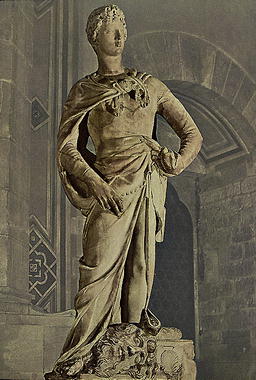
One of the famous artists of the Renaissance was Donato di Niccolo di Betto Bardi, more commonly known as Donatello. He was born in 1386 in Florence, Italy during the early Renaissance. He lived until 1466. In his youth he began painting, and was interested in nature and the humanism ideas. As he grew older he studied ancient Greek and Roman works, and was influenced by them to revive many classical forms of art. He is known mainly as a sculptor, and made many actual sized figures which had not been done since ancient times. He created the first free standing sculptures, not needing any additional architecture or decoration. Donatello treated his works as if they had distinct personalities, rather than just an ordinary thing. His prime influence was Lorenzo Ghiberti, whom Donatello assisted for many years before working on his own. Ghiberti was a famous Italian sculptor who sculpted many religious scenes. Ghiberti lived from 1378 to 1455, the same time that Donatello lived. Donatello created two works using techniques from Ghiberti, and these works were not always graceful, but they still captured the viewers eye. His style was not normal, but was still appealing enough that people did not treat his work badly, instead they accepted it and used it to base future works on. Because of his different style compared to other artists at the time, he is often called the founder of the Renaissance style.
Donatello's career can be divided into three periods. The first period is marked by his gothic style workwhich also showed classical and realistic features. Among these works is his St. George. His second period of work is marked by a reliance on the principles of the sculpture of antiquity. In this time, he worked with many other artists to create joint projects. Most of his partners focused on the architectural aspects around the sculpture, while Donatello created the sculptures himself. During this period he created his David, which was the first nude sculpture of the Renaissance. In Donatello's third period of work, he broke away from classical influence and his old style of sculpting, and began to sculpt figures realisticly to how his subject actually acted. He focused more on dramatic action than the classical graceful and peaceful art. He started to use more distortion to show the realistic emotions he was trying to express. One of his works during this period of his career is his Equestrian monument of Gattamelata.
Donatello was an all-around sculptor. He was equally as skilled in low-relief sculptures as high-relief, which means the amount of raised and lowered surfaces used in a composition, as well as in using wood, marble, bronze, or other metals. His use of different reliefs gives each work a different personality and feel, showing different ranges of lights to darks, and different types of shadows. He was also the first of his time to use reliefs within the rules of perspective.
Donatello's many works laid the foundation for sculptors and other artists of the Renaissance to build on. With his revival of ancient techniques and ideas, he gave a rebirth to ancient culture and used these ideas and thoughts to help form a revival of the arts. He also helped shape what would become one of the greatest cultures throughout time, the culture that existed during the Renaissance.